Research Interests - Current Projects

Mineral Chemical Studies
Sawtooth Metamorphic Complex, ID, USA:
Precambrian Crustal Evolution in Western Laurentia
Staurolite
Western Maine, USA - Contact-Regional Metamorphism
Tourmaline as a Petrogenetic Indicator Mineral
3-D Computational Modeling - Heat and Mass Transport
Constraining the age and extent of Precambrian crust accreted to western Laurentia is imperative for deciphering the tectonic evolution of North America. Crust in the form of high-grade metamorphic rocks of the Sawtooth metamorphic complex (SMC) occupies a crucial location between the Archean Wyoming craton and the Neoproterozoic rifted margin of ancestral Laurentia. This research tests the hypothesis that this crust, variously referred to as Selway, Wallace, and Great Falls tectonic zone (GFTZ), represents a discrete crustal terrane, distinctly different in character and lithology from adjoining Archean and Mesozoic terranes. We are constraining its age and evolution through an integrated field, petrologic, mineralogical and isotopic study. Extensive Mesozoic and younger supracrustal rocks make exposures of Precambrian rocks in this region rare.
U/Pb dating of zircons with whole-rock major element, trace-element, and isotopic analyses ascertains ages, compositions, and provenance of the protoliths. Classical geothermometry based on mineral chemistry and phase equilibrium modeling used to determine the burial conditions and P-T path of the SMC. U-Pb-Th dating of monazite are used to develop P-T-t path(s) and determine the tectonic setting of metamorphism. The time at which the SMC acquired its current structure and high metamorphic grade will place a firm upper limit on the time of assembly of the Sawtooth domain crust. These data will provide the temporal resolution needed to constrain tectonic models proposed for the development and evolution of western Laurentia during and subsequent to the Proterozoic. Additionally, this work addresses several other significant problems in western Laurentian geology including: Does the deep crust of this region carry any thermochronological record of a Grenville-age orogeny proposed for the region directly to the north? Does the SMC contain a record of Neoproterozoic rifting, e.g., extensional structures associated with a thermal pulse at that time? Resolving whether the Sawtooth domain ultimately represents in-situ magmatic growth of Laurentia, a new accretionary event, or another component of a previously proposed crustal province is an important objective of this work. The integrated petrologic and thermochronologic study will also provide crucial data for regional correlations.
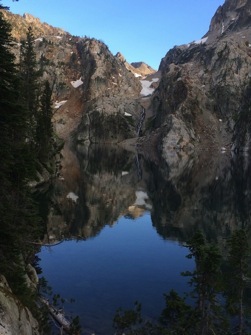
Photo (c) Barb Dutrow
Computational modeling provides a complementary approach to decipher the thermal and fluid evolution of magma-hydrothermal systems. Such systems contain multiple non-linear feedbacks that significantly alter their evolution, modeling provides one mechanism to evaluate their impacts and consequences.
We have developed a time transient 3-D model for magma-hyrothermal systems with specific reference to processes occurring in both the host rocks and the pluton. Applications of our modeling include, e.g., understanding the thermal evolution of specific metamorphic systems and the resultant isograd patterns (i.e. Maine, U.S.A.); providing temperature constraints in the absence of geothermometric mineral assemblages are absent (i.e. subsurface Louisiana); determining the heating rates of rocks; evaluating the time scales of metamorphism; the impact of fluids on P-T-t paths; the impact of silica transport on fluid flow and several other studies.
Collaborators:
Carl W. Gable and
Bryan Travis,
Los Alamos National Lab.

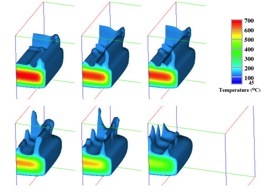
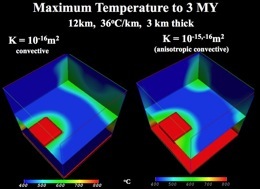
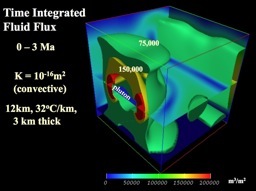
Thermal evolution in a system with SiO2 that feeds back on permeability.
(Dutrow et al., 2001, GCA)
Textural Evolution of Metapelitic Rocks
Together with C.T. Foster, Jr. (Univ. Iowa), we are evaluating the impact of heat transport and fluid flow on the textural development of metapelitic rocks through a combination of modeling techniques. Heat and mass transport modeling provides the requisite data for irreversible modeling of mineral textural development.
Metaturbidite - with staurolite developed in Al-rich layers and absent in quartz-rich layers. Maine. Photo: (c) Darrell Henry.
Collaborators: Paul Mueller and David Foster, Univ. Florida ( & the SMC students)
The tourmaline supergroup minerals are extraordinary recorders of their geologic evolution. Their accommodating crystal structure permits ions with a wide range of sizes and charges, such that tourmalines readily adjust their composition to the host rock environment. Once this signature is embedded it is retained due to negligible diffusion. Tourmaline is stable over a large pressure-temperature region from near the Earth surface to lower crustal conditions and from diagenesis to melting. Tourmaline requires boron to form and is thus an excellent indicatorsof B-bearing fluids both internally or externally derived.
Due to their chemical and mechanical stability, they are one of the “Big Three” refractory minerals and are valuable provenance indicators.
A number of projects are currently underway involving crystallochemical aspects, fluid flow indicators, thermodynamic properties, behavoir during metamorphism, as provenance indicators, etc. Please see our Elements issue (2011) on Tourmaline.
Collaborators: Darrell Henry (primary) and many others.
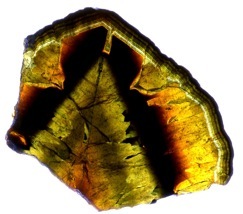
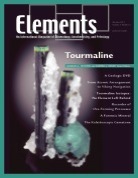
Optical scan of zoned tur, Madagascar.
Staurolite is an index mineral for medium-grade metapelitic rocks. It incorporates significant amounts of Li and has variable H contents. As such, its thermodynamic and stability relations remain uncertain. However, it’s crystal size distribution may provide information on the heating rates of the rocks.
During prograde metamorphism, it is commonly pseudomorphed by muscovite. The composition of these pseudomorphs provides insights into the thermal and fluid evolution of the terranes.
Research continues into the mineral chemical aspect of staurolite and its Li contents (with N. Miller, UTX), its textural development (with C.T. Foster, Jr. U Iowa), and its thermodynamics.
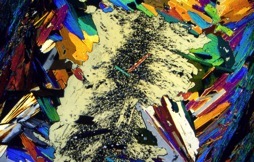
Mus pseudomorph after st. XPL Farmington, ME. FoV = 3.2 mm. Photo: B. Dutrow

Minerals as complex systems
Minerals can be excellent recorders of complexity found in the Earth's system. A rock's mineralogy and texture are not only products of thermally activated chemical reactions in the solid state but also influenced by fluids percolating through the intervening pore space. In these geologic settings, fluids flow in response to density gradients set up by the transfer of thermal energy. In turn, this causes changes in fluid compositions. When these rapidly evolving fluids interact with a growing mineral they cause resultant chemical changes to be recorded in the mineral. While some fluid interaction is subtle and has little compositional impact, rapidly changing chemical conditions can be manifest in spectacular chemical zoning patterns in minerals
Western Maine, USA, is a classical contact regional terrane where isograds broadly correspond to exposed plutons (contact) but mineral textures are coarse and appear regional in nature.
Our work combines thermal and flow modeling with textural modeling to undestand the development of these enigmatic terranes. Many field seasons and hundreds of samples provide the foundational studies needed for the modeling work.

Slice of a 3-D domain showing calculated isograds. Using anisotropic permeability and near contemporaneous emplacement, mapped isograds can be matched. (Dutrow calculation)